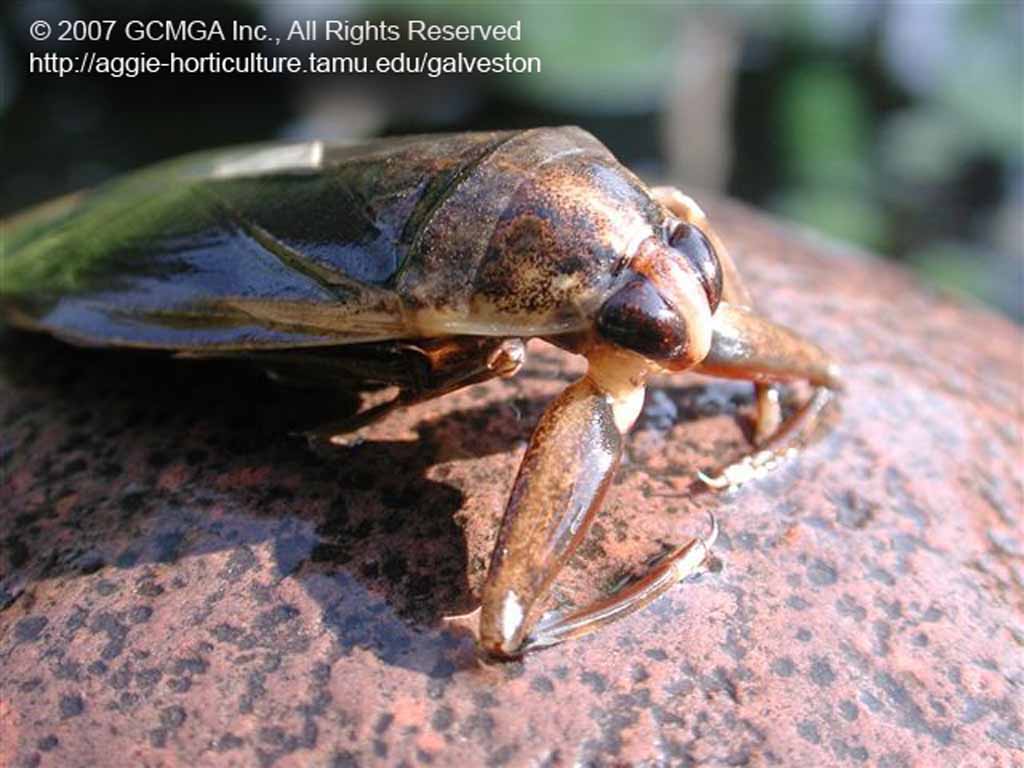| Common Name: | Giant Water Bug |
| Other Common Name: | Electric Light Bug and Toe-Biter |
| Genus / Species: | Lethocerus americanus |
| Size: | Adults can be over 2 inches long |
| Type of Beneficial: | Insect predator |
| Type of Metamorphosis: | Immature stages similar in appearance to the adult stage (i.e., simple metamorphosis) |
| Beneficial Stage(s): | Both adults and immatures (known as nymphs) are predators |
| Prey: | Wide range of prey including aquatic insects (larvae and adults), crustaceans, tadpoles, salamanders, fish, and amphibians |
| Occurrence: | Overall populations are low but occur throughout Galveston-Houston area. |
| Mounted Specimen? | Yes (mounted specimen for viewing available in insect collection at County Extension Office) |
More Information
With the Giant Water Bug (Lethocerus americanus), nature has outdone itself on the weirdness scale. This aquatic bug breathes through its behind, carries its own air supply, devours mosquito larvae and the males of some species take care of the kiddies. Sound like husband material to you? It would to me.if I were a female Lethocerus americanus!
Giant Water Bugs are members of the order Hemiptera, true bugs. They are the largest true bug in the United States and Canada, growing up to 4 inches in length. Sometimes confused with a roach or beetle, the Giant Water Bug has a flat, oval-shaped body that is tan or brown. A closer look will reveal a short, pointed beak on the underside of the head and wings that overlap at the bottom end of the abdomen, forming an “X.”
Its body design makes the Giant Water Bug a formidable predator, well-suited for hunting in its habitat. The forelegs are tipped with a hook-shaped claw to grasp and hold prey. Water bugs swim with their flattened hind legs that resemble oars. Using its hind legs, the bug grabs hold of a plant growing close to the surface of a fresh water pond or stream and snatches passing prey with its powerful front legs. Instantly, the Giant Water Bug pierces its victim with its sharp beak and injects a powerful toxin. The toxin has two purposes. First, it paralyzes the prey. Then, it liquefies the internal parts of the prey’s body so the hunter can suck up a liquid repast.
The potential menu for a Giant Water Bug is impressive, including aquatic insects (larvae and adults), crustaceans, tadpoles, salamanders, fish, and amphibians. The Giant Water Bug can catch and eat an animal 50 times its size, the equivalent of a person slurping up a whole elephant milkshake in one sitting!
The life cycle of the Giant Water Bug involves simple metamorphosis: egg to nymph to adult in 1-2 months. Adults live about one year. A female B. lethocerus lays her eggs above water on plants and other objects. B. abedies and B. belostoma females lay their eggs on the back of the males, and that is the extent of female parenting responsibilities. Males carry the eggs until they hatch, taking care to expose them to air periodically to prevent the growth of fungus. They also “brood pump”: making water move over the eggs to increase oxygen diffusion.
A unique adaptation to living in the water is the manner in which a Giant Water Bug breathes. Snorkel-like breathing tubes are located at the hind end of the abdomen. These tubes extend to the surface of the water, where they allow for an exchange of air from the atmosphere to a bubble of air the bug keeps trapped beneath its wings. From the bubble, air enters the body through spiracles (holes) in the abdomen.
Giant Water Bugs have found our water garden at the County Extension Office to be suitable for living. While Giant Water Bugs are active all year, they are most active in late summer and early fall. Then, they fly from the shallows to search for deeper water where they can remain moderately active during cooler winter weather. This is the time during which they are most likely to make contact with people.
Because they are attracted to light, we often find them in parking lots and under porch lights: hence the nickname “electric light bug.” If you find one alive, either avoid handing it at all or handle with much caution. Water bugs can inflict a painful bite, the source of another common name, “Toe Biter.”
The bite is not considered medically dangerous, unless the victim happens to have an allergic reaction to it. While these insects don’t hunt for us, they will defend themselves or go after something in their habitat that looks like lunch.

